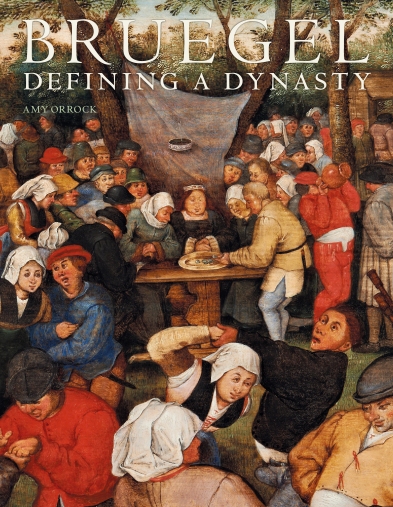Invitation To Celebration
Pieter Brueghel the Younger’s “Wedding Dance in the Open Air” invites us to a lively celebration. As we approach the scene, nestled within a forest clearing, our attention is drawn to the focal point: the bride, surrounded by revelers. Further, Seated at a table adorned with a simple canopy between two trees, she wears a regal crown and a square-necked, fur-trimmed gown, exuding contentment as she admires the growing pile of coins, her wedding gifts.
The setting is surrounded by winding tree trunks leading up to a bright sky and adorned with shimmering leaves. Beneath the lush green canopy, peasants energetically pound the ground with their heavy footsteps. These individuals, often depicted as rough or ‘Bruegelian’, have knobby knees and rustic attire, some indulging in freely poured drinks, revealing protruding bellies.
Amidst the scene, couples embrace, kiss, strain to get a better view of the main event, or discreetly find relief against a wall. The focal point is on the lively dancers in the foreground, lifting their skirts and emphasizing their codpieces as they dance, their fingers intertwined and noses glistening. The only ones showing signs of weariness are the two bagpipers, who lean against a tree, their gazes suggesting a longing to escape the scene.
Also Read: VIDEO: A Chat With Philip Mansel, Author Of ALEPPO
The Legacy Of The Bruegel Dynasty: Pioneers Of Peasant Scenes
Pieter Brueghel the Elder, credited with pioneering the genre of peasant pictures, laid the foundation for the celebrated Bruegel dynasty. Karel Van Mander immortalized Bruegel as a sixteenth-century infiltrator, portraying him as someone who disguised himself as a peasant at weddings to authentically capture the revelry of the guests, showcasing Bruegel’s acute observation skills.
Through his art, Bruegel elevated the humble peasant to a monumental status, symbolizing the Netherlandish people’s noble and authentic culture during the Spanish Habsburg rule.
Scholars believe that Pieter Bruegel the Elder originated the original composition of the Wedding Dance in the Open Air, although such works were scarce by the early 17th century. Further, Due to Bruegel the Elder’s untimely death and limited artistic output, his eldest son, Pieter Brueghel the Younger, stepped in to fill the void.
Despite being only four years old when his father passed away, Pieter the Younger continued depicting peasant scenes. He employed a method of serial reproduction in his Antwerp workshop, using cartoons to replicate popular motifs. The Wedding Dance in the Open Air has emerged as one of his most successful compositions, with over a hundred versions existing today, a significant portion of which scholars attribute to Pieter Brueghel the Younger himself.
Insights From Conservation: The Wedding Dance In The Open Air
Recent examination and conservation efforts on the Wedding Dance in the Open Air have unveiled its exceptional quality. A meticulous under-drawing and delicate paint application hint at the involvement of the master artist rather than an assistant.
By comparing it with other renditions of the scene, the painting at the Holburne Museum has been more precisely dated. Notably, the vibrant blue hue of one dancer’s jacket places it among versions painted between 1607 and 1614, distinguishing it from later iterations where the jacket appears brown.
Exhibition Highlight: The Wedding Dance In The Open Air At ‘Bruegel: Defining A Dynasty
The painting, unique in a UK public collection, takes center stage at the Holburne Museum’s exhibition ‘Bruegel: Defining a Dynasty’ from February 11 to June 4. Here, the exhibition presents it alongside numerous other artworks by Pieter Brueghel the Younger and representatives from four successive generations of the esteemed Bruegel family.
After undergoing restoration and returning to public display after many years, the Wedding Dance in the Open Air now radiates with its original vibrant colors and captivating details. Similarly, serving as a charming testament to the Bruegel dynasty’s enduring appeal, the painting invites viewers to immerse themselves in its joyful celebration.
Amy Orrock, an independent art historian and curator, earned her PhD from the University of Edinburgh, focusing on Pieter Bruegel the Elder’s “Children’s Games.” With a broad expertise in Flemish art from the sixteenth and seventeenth centuries, she has delivered numerous publications and lectures on the subject. Orrock has undertaken various projects, including collaborations with institutions such as the Royal Collection Trust, Compton Verney in Warwickshire, and the National Portrait Gallery in London, where she produced “Elizabeth I and Her People” (2013).
You can currently view the exhibition “Bruegel: Defining a Dynasty” at The Holburne Museum in Bath until June 4th. Further, you can purchase the accompanying catalog published by Philip Wilson Publishers.



